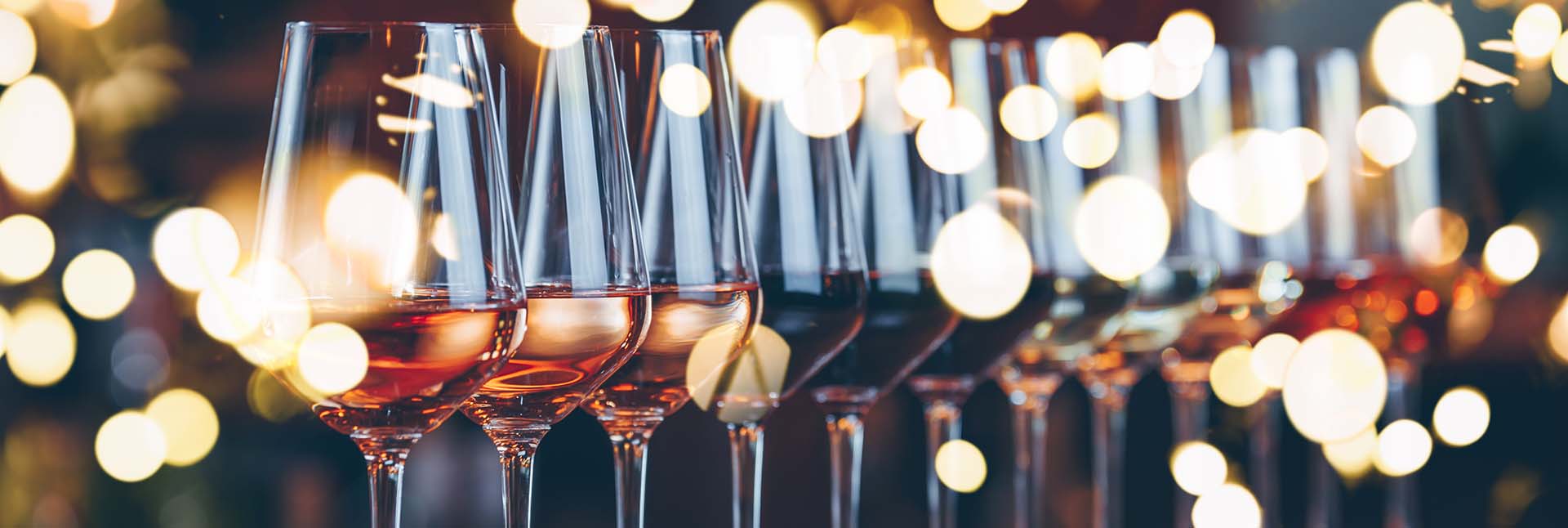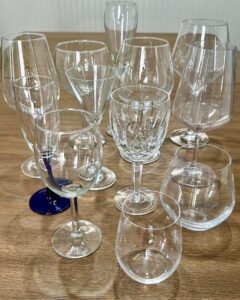Choosing the Best Wine Glass (For You)

Whether you’re new to wine or a long-time connoisseur, choosing the right glass can make a big difference in your enjoyment of the wine you drink. This article will hopefully help in choosing the best wine glass for you. Let’s start with some basic considerations to make before buying your next set of wine glasses.

Size – This photo gives you an idea of just a small sample of types of wine glasses available these days. You can buy an inexpensive set of “all-purpose” wine glasses to use with red, white or rose, but even that won’t address Champagne, Port, Sherry and others wines from regions around the world that have traditionally been consumed from different shaped glasses. Books have been written about wine glasses, so this blog will just highlight the most common choices.
Bordeaux Wine Glasses
Did you know that the shape of the glass can enhance the flavor of your wine? Bordeaux (Cabernet Sauvignon, Merlot, and other full bodied wine) glasses are tall with a relatively small bowl which directs the wine to the back of your mouth where your taste buds can pick up the flavors of these wines. This shape also enhances the aromas of these wines.
Burgundy Wine Glasses
Burgundy wine glasses have a medium-tall stem and a large bowl. The tall stem allows you to swirl the wine to expose more oxygen to “open” the aromas. The big bowl allows you to really get your nose into the bowl and bring in more of the scent. The thin rim directs the wine to the tip of your tongue where the taste buds there can appreciate more of the acidic flavors of these wines. Burgundy wines are Pinot Noir and Chardonnay.
Champagne Wine Glasses
Champagne wine glasses generally come in three styles, flutes, coupe and tulip. While the coupe style was quite popular in the 1800’s, it is less popular these days, perhaps because while visually appealing, they let the bubbles dissipate very quickly. (Fun fact: The shape of this glass has long been believed to be modeled on Marie-Antoinette’s breast.) The flute style of Champagne glass became more popular in the 1920’s when Champagne became more accessible to the average person. These are still the most popular style. The tulip style which dates from the 1930’s has a long, thin stem and a wider bowl that narrows at the rim. This style enhances the aromas, but keeps the bubbles from disappearing too quickly.
To Stem or Not to Stem
The flavor of wine in your glass is greatly affected by temperature. Glasses with stems give you a convenient place to hold your glass without altering the proper temperature of the wine. Stemless glasses, while convenient, must be held by the bowl, and will quickly warm your wine. This will affect the flavor of the wine and is even more of a negative with white, rose’ and those red wines which are more commonly served chilled. One factor in favor of stemless glasses is that they are more convenient to store.
Plastic “Glasses”
Relatively new to wine are plastic “glasses.” These come in a variety of shapes as well as stemmed and stemless. While they don’t enhance the aroma and flavor of wine the way that crystal and glass do, they are a great choice for those times you want to enjoy wine in the yard, by the pool, while traveling, etc. Modern versions are surprisingly durable, so dropping these is usually not a problem (unless there was still wine in it!) The price of plastic versions can be cheaper than glass, and MUCH cheaper than high-end crystal.
I hope this brief overview gives you some useful information before selecting your next set of wine glasses. Picking the right wine glasses can take your wine appreciation to another level. And if you’re looking for a hands-free way to hold a wine glass at your next gathering, check out our Party Plates!

